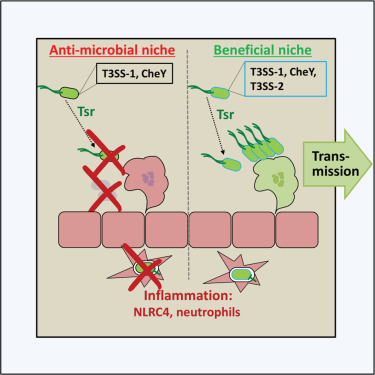New paper in Cell Reports by the Hardt Lab
Salmonella T3SS-2 virulence enhances gut-luminal colonization by enabling chemotaxis-dependent exploitation of intestinal inflammation
Ersin Gül, Jemina Huuskonen, Andrew Abi Younes, Luca Maurer, Ursina Enz, Jakob Zimmermann, Mikael E. Sellin, Erik Bakkeren, Wolf-Dietrich Hardt (2024)
external pageCell Reports 43, 113925. https://doi.org/10.1016/j.celrep.2024.113925

Salmonella Typhimurium (S.Tm) utilizes the chemotaxis receptor Tsr to exploit gut inflammation. However, the characteristics of this exploitation and the mechanism(s) employed by the pathogen to circumvent antimicrobial effects of inflammation are poorly defined. Here, using different naturally occurring S.Tm strains (SL1344 and 14028) and competitive infection experiments, we demonstrate that type-three secretion system (T3SS)-2 virulence is indispensable for the beneficial effects of Tsr-directed chemotaxis. The removal of the 14028-specific prophage Gifsy3, encoding virulence effectors, results in the loss of the Tsr-mediated fitness advantage in that strain. Surprisingly, without T3SS-2 effector secretion, chemotaxis toward the gut epithelium using Tsr becomes disadvantageous for either strain. Our findings reveal that luminal neutrophils recruited as a result of NLRC4 inflammasome activation locally counteract S.Tm cells exploiting the byproducts of the host immune response. This work highlights a mechanism by which S.Tm exploitation of gut inflammation for colonization relies on the coordinated effects of chemotaxis and T3SS activities.
